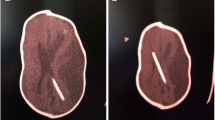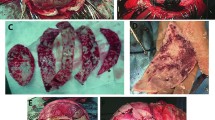Abstract
Purpose
The primary objective of this study is to investigate post-operative morbidity and shunt revision rates of patients with shunt-dependent hydrocephalus (SDH) undergoing posterior vault distraction osteogenesis (PVDO) compared to patients undergoing conventional posterior vault reconstruction (PVR).
Methods
A retrospective case-controlled cohort analysis of all patients with SDH undergoing PVDO and PVR for syndromic or complex craniosynostosis was performed. Demographic information, perioperative variables, distraction protocols, and shunt-related complications—infection, surgical revision of shunt, increased length of stay (LOS), and readmission within 90 days of surgery—were compared using the appropriate statistical tests.
Results
Fourteen patients with ventricular shunts who underwent PVDO and eight patients with shunts who underwent PVR were identified. Shunt-related complication rates were significantly higher with PVDO (n = 5) compared to PVR (n = 0), p = 0.0093. Among the five patients who suffered complications, the most common were shunt infection (n = 4), shunt malfunction (n = 4), and wound infections (n = 3). All patients with complications required additional operations for shunt revision and/or replacement; four patients required multiple takebacks for such procedures, with an average of three additional procedures per patient.
Conclusions
In complex or syndromic craniosynostosis patients who have previously undergone ventricular shunting, PVDO is associated with higher shunt-related complications and need for additional procedures when compared to traditional PVR. While the benefits of PVDO in the treatment of syndromic craniosynostosis are well documented, the risks of PVDO in the face of a VP shunt must be considered. Further investigation into patient-specific risk factors and risk reduction strategies is warranted.
Similar content being viewed by others
References
Buchanan EP, Xue AS, Hollier LH (2014) Craniofacial syndromes. Plast Reconstr Surg 134(1):128e–153e. https://doi.org/10.1097/PRS.0000000000000308
Panchal J, Uttchin V (2003) Management of craniosynostosis. Plast Reconstr Surg 111(6):2032–2048; quiz 2049. https://doi.org/10.1097/01.PRS.0000056839.94034.47
Morris L (2016) Management of craniosynostosis. Facial Plast Surg 32(2):123–132. https://doi.org/10.1055/s-0036-1582228
David LR, Proffer P, Hurst WJ, Glazier S, Argenta LC (2004) Spring-mediated cranial reshaping for craniosynostosis. J Craniofac Surg. 15(5):810–818
Wong GB, Kakulis EG, Mulliken JB (2000) Analysis of fronto-orbital advancement for Apert, Crouzon, Pfeiffer, and Saethre-Chotzen syndromes. Plast Reconstr Surg 105(7):2314–2323
Mackenzie KA, Davis C, Yang A (2009) R MM. Evolution of surgery for sagittal synostosis: the role of new technologies. J Craniofac Surg. 20(1):129–133. https://doi.org/10.1097/SCS.0b013e318190e1cf
White N, Evans M, Dover MS, Noons P, Solanki G, Nishikawa H (2009) Posterior calvarial vault expansion using distraction osteogenesis. Childs Nerv Syst 25(2):231–236. https://doi.org/10.1007/s00381-008-0758-6
Renier D, Lajeunie E, Arnaud E, Marchac D (2000) Management of craniosynostoses. Childs Nerv Syst 16(10-11):645–658. https://doi.org/10.1007/s003810000320
Sgouros S, Goldin JH, Hockley AD (1996) System MJC. Posterior skull surgery in craniosynostosis. Child’s Nerv Syst
Choi M, Flores RL, Havlik RJ (2012) Volumetric analysis of anterior versus posterior cranial vault expansion in patients with syndromic craniosynostosis. J Craniofac Surg. 23(2):455–458
Goodrich JT (2004) Craniofacial surgery: complications and their prevention. Semin Pediatr Neurol 11(4):288–300
Goldstein JA, Paliga JT, Wink JD, Low DW, Bartlett SP, Taylor JA (2013) A craniometric analysis of posterior cranial vault distraction osteogenesis. Plast Reconstr Surg 131(6):1367–1375. https://doi.org/10.1097/PRS.0b013e31828bd541
Derderian CA, Wink JD (2015) L MJ, Collinsworth A, Bartlett SP, Taylor JA. Volumetric changes in cranial vault expansion: comparison of fronto-orbital advancement and posterior cranial vault distraction osteogenesis. Plast Reconstr Surg 135(6):1665–1672. https://doi.org/10.1097/PRS.0000000000001294
Taylor JA, Derderian CA, Bartlett SP, Fiadjoe JE, Sussman EM, Stricker PA (2012) Perioperative morbidity in posterior cranial vault expansion: distraction osteogenesis versus conventional osteotomy. Plast Reconstr Surg 129(4):1–3. https://doi.org/10.1097/PRS.0b013e3182443164
Copeland AE, Hoffman CE, Tsitouras V, Jeevan DS, Ho ES, Drake JM, Forrest CR (2018) Clinical significance of venous anomalies in syndromic craniosynostosis. Plast Reconstr Surg - Glob Open 6(1):e1613. https://doi.org/10.1097/GOX.0000000000001613
Collmann H, Sörensen N, Krauss J, Mühling J (1988) Hydrocephalus in craniosynostosis. Childs Nerv Syst 4(5):279–285
Collmann H, Sörensen N, Krauß J (2005) Hydrocephalus in craniosynostosis: a review. Childs Nerv Syst 21(10):902–912. https://doi.org/10.1007/s00381-004-1116-y
Sgulò FG, Spennato P, Aliberti F, Di Martino G, Cascone D, Cinalli G (2017) Contemporary occurrence of hydrocephalus and Chiari I malformation in sagittal craniosynostosis. Case report and review of the literature. Childs Nerv Syst 33(1):187–192. https://doi.org/10.1007/s00381-016-3189-9
Bhasin RR, Chen MK, Pincus DW (2007) Salvaging the “lost peritoneum” after ventriculoatrial shunt failures. Childs Nerv Syst 23(5):483–486. https://doi.org/10.1007/s00381-006-0292-3
Del Bigio MR (2004) Cellular damage and prevention in childhood hydrocephalus. Brain Pathol 14(3):317–324
Cochrane DD, Kestle JR (2003) The influence of surgical operative experience on the duration of first ventriculoperitoneal shunt function and infection. Pediatr Neurosurg 38(6):295–301. https://doi.org/10.1159/000070413
Gottfried ON, Binning MJ, Sherr G, Couldwell WT (2005) Distal ventriculoperitoneal shunt failure secondary to Clostridium difficile colitis. Acta Neurochir {(Wien)} 147(3):335–338; discussion 338. https://doi.org/10.1007/s00701-004-0444-8
Tamburrini G, Caldarelli M, Massimi L, Gasparini G, Pelo S, Di Rocco C (2012) Complex craniosynostoses: a review of the prominent clinical features and the related management strategies. Childs Nerv Syst 28(9):1511–1523. https://doi.org/10.1007/s00381-012-1819-4
Derderian CA, Bastidas N, Bartlett SP (2012) Posterior cranial vault expansion using distraction osteogenesis. Childs Nerv Syst 28(9):1551–1556. https://doi.org/10.1007/s00381-012-1802-0
Lollis SS, Mamourian AC, Vaccaro TJ, Duhaime AC (2010) Programmable CSF shunt valves: radiographic identification and interpretation. Am J Neuroradiol 31(7):1343–1346. https://doi.org/10.3174/ajnr.A1997
Wiberg A, Magdum S, Richards PG, Jayamohan J, Wall SA, Johnson D. Posterior calvarial distraction in craniosynostosis—an evolving technique. J Craniomaxillofac Surg 2012;40(8):799-806. doi:https://doi.org/10.1016/j.jcms.2012.02.018
Thomas GP, Wall SA, Jayamohan J et al (2014) Lessons learned in posterior cranial vault distraction. J Craniofac Surg 25(5):1721–1727. https://doi.org/10.1097/SCS.0000000000000995
Zhang RS, Wes AM, Naran S, Hoppe IC, Sun J, Mazzaferro D, Bartlett SP, Taylor JA (2018) Posterior vault distraction osteogenesis in nonsyndromic patients: an evaluation of indications and safety. J Craniofac Surg. 29(3):566–571. https://doi.org/10.1097/SCS.0000000000004230
Greives MR, Ware BW, Tian AG, Taylor JA, Pollack IF, Losee JE (2016) Complications in posterior cranial vault distraction. Ann Plast Surg 76(2):211–215. https://doi.org/10.1097/SAP.0000000000000518
Woo PY, Wong HT, Pu JK et al (2016) Primary ventriculoperitoneal shunting outcomes: a multicentre clinical audit for shunt infection and its risk factors. Hong Kong Med J 22(5):410–419. https://doi.org/10.12809/hkmj154735
Prusseit J, Simon M, von der Brelie C, Heep A, Molitor E, Volz S, Simon A (2009) Epidemiology, prevention and management of ventriculoperitoneal shunt infections in children. Pediatr Neurosurg 45(5):325–336. https://doi.org/10.1159/000257520
Choux M, Genitori L, Lang D, Lena G (1992) Shunt implantation: reducing the incidence of shunt infection. J Neurosurg 77(6):875–880. https://doi.org/10.3171/jns.1992.77.6.0875
McGirt MJ, Zaas A, Fuchs HE, George TM, Kaye K, Sexton DJ (2003) Risk factors for pediatric ventriculoperitoneal shunt infection and predictors of infectious pathogens. Clin Infect Dis 36(7):858–862. https://doi.org/10.1086/368191
Erps A, Roth J, Constantini S, Liat L-G, Galia G-S (2018) Risk factors and epidemiology of pediatric ventriculoperitoneal shunt infection. Pediatr Int. https://doi.org/10.1111/ped.13709
MJ MG, Zaas A, Fuchs HE, George TM, Kaye K, Sexton DJ (2003) Risk factors for pediatric ventriculoperitoneal shunt infection and predictors of infectious pathogens. Clin Infect. https://doi.org/10.1086/368191
Author information
Authors and Affiliations
Corresponding author
Ethics declarations
Conflict of interest
None of the authors has a financial interest in any of the products, devices, or drugs mentioned in this manuscript.
Additional information
Publisher’s note
Springer Nature remains neutral with regard to jurisdictional claims in published maps and institutional affiliations.
Rights and permissions
About this article
Cite this article
Azzolini, A., Magoon, K., Yang, R. et al. Ventricular shunt complications in patients undergoing posterior vault distraction osteogenesis. Childs Nerv Syst 36, 1009–1016 (2020). https://doi.org/10.1007/s00381-019-04403-w
Received:
Accepted:
Published:
Issue Date:
DOI: https://doi.org/10.1007/s00381-019-04403-w




